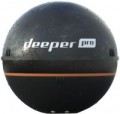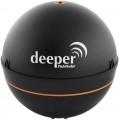Scan depth
the
maximum depth at which the sonar locator (see "Type") is able to operate effectively — in other words, how deep underwater the device is able to "see".
It is worth choosing an echo sounder according to this parameter, taking into account the actual depths at which it is planned to be used. Of course, this does not place a certain margin, but within reasonable limits (15-20%, less). For example, it hardly makes sense to specially take a model with a scanning depth of 200 m for a lake with pits of 30-40 m — such devices are expensive, while there will simply be nowhere to realize their full potential, and a powerful signal can also scare away the fish. But for marine or oceanic applications, a depth of a kilometer or more may be required; the most advanced echo sounders are quite capable of providing it.
Functions
—
3D maps. Support for maps rendered using 3D graphics. This provides additional visibility in the work: the relief on the screen can be seen not in the form of conditional lines and colour spots, but in the form of protrusions and depressions, the shape of which most closely matches the real shape of the surface. In this case, the three-dimensional image can be supplemented with colour and/or numerical indication to clarify additional data (for example, specific depth values). This feature is typical for high-end models with the chartplotter function (see "Type").
— Sound alarm. The presence of an audible alarm in the design of the device. The types of alarms and their triggering situations can be different: fish detection, critical depth reduction (see
“Shoal/Shoal” below), reaching a checkpoint,
man overboard(see below), etc. However, anyway, this type of notification is more reliable than graphic indication on the screen — the user does not have to look at the device to hear the sound. This greatly reduces the risk of missing an important message.
—
Determining the distance to the fish. Ability to determine the distance to the fish detected by the echo sounder. Usually, we are talking about the distance in depth, and the indication itself can be carried out in different ways: in some models, fish marks are displaye
...d opposite the depth scale, in others, a specific value can be given for each mark separately.
— Indication of symbols in the form of fish. The ability to display on the screen a signal from a fish detected by an echo sounder in the form of, in fact, “fish” icons. This option is better suited for non-professional users than standard icons in the form of arcs of various shapes: working with arcs requires some practical knowledge to distinguish fish from other signal sources, and in the case of “fish”, the device itself solves this task for the user. Of course, no such system is perfect, and therefore false positives are not ruled out; on the other hand, recognition technologies are constantly improving. Many echo sounders with this function even have a gradation according to the size of prey — large, medium, small.
— Indication of fish in real time. In devices with this function, fish signals are displayed on the screen when a fish enters the echo sounder beam — and disappear when it leaves the beam. This allows you to track the movements of potential prey as quickly as possible and evaluate the prospects of a particular location — while models without real-time indication display marks constantly, upon detection of fish, and make it difficult to assess its movements.
— Fast screen refresh. The refresh rate of the echo sounder screen determines how evenly the relief “visible” by the device is drawn on this screen. This parameter is important when moving at high speed: if the screen is updated slowly, there is a high probability of the appearance of "steps" with sharp drops — due to the fact that the device did not have time to process and display data on the bottom section passed. By “fast” update is meant a mode that allows you to comfortably use the echo sounder at high speed; for different manufacturers, the specific values \u200b\u200bof this speed may vary, however, usually, we are talking about at least 30 – 40 km/h, developed by powerful motor boats.
— Shallow water/shallow. This function provides an indication of a critical decrease in depth, fraught with grounding with all the associated unpleasant consequences. The depth at which the alarm is triggered can most often be set at the request of the user.
— Automatic change of depth scale. Automatic change of scale of the image on the screen depending on the depth "seen" by the echo sounder. This function adjusts the screen of the device so that the entire scanned volume of water from the surface to the bottom is completely visible on it, and it is not necessary to move the image up and down to assess the situation. For example, at depths of 35-40 m, a model with auto-zoom can use a 50-metre scale, and when reaching greater depths, switch to 80- or 100-metre, at smaller depths, to 20-metre, etc. At the same time, automatic adjustment "makes life easier" for the user, eliminating the need to adjust the scale manually.
— Displayed depth range. The ability to manually set the device to a specific depth range shown on the display — so that the space above and below this range will be outside the screen. This function can be useful, for example, to search for fish walking in a certain depth range; while limiting the range allows you to get an image on a larger scale than when viewing the entire space from the surface to the bottom.
— Determination of bottom density. The ability to use an echo sounder to determine the density of the bottom surface. A device with this function allows you to determine what is under the vessel — stone, sand or soft silt; this information may be useful when catching some types of fish. In addition, bottom density data is useful when searching for underwater objects — for example, sunken ships are often distinguished by "hard" spots on a soft surface.
— Indication of water temperature. Possibility to display the water temperature on the device screen. The specific features of such an indication can be different: some models show only data on the water in direct contact with the sensor (that is, in fact, the temperature on the surface), others are also able to display data on the thermocline (temperature jump layer).
— Indication of speed. The ability to display the speed of movement on the screen of the device. This feature provides additional information and can be useful even on boats equipped with their own speedometers — getting speed data directly on the sonar / chartplotter screen is often more convenient than being distracted by a separate device. This data can come from different sources — for example, from a GPS module or from a specialized sensor (log).
— Display of the distance traveled. The ability to display the distance traveled on the screen of the device. Features of this function may vary depending on the model: in the simplest devices only the total distance traveled is shown, more advanced ones (usually with a chartplotter function, see "Type") can also draw the route on the map.
— Function "man overboard". As the name suggests, this feature facilitates rescue operations in the event of a person falling overboard. The specific functionality associated with this may vary in different models, but usually there is at least the ability to quickly fix the scene in the device and switch it to the navigation mode to this point. And in more advanced models, DSC maritime radio communications may also be provided, as well as the reception and processing of similar signals from other ships.Connection interfaces
—
Ethernet. This standard is also known as LAN or RJ-45. Its original purpose is the construction of general-purpose wired computer networks; however, Ethernet can also be used in special networks — including used by navigation equipment. Note that this interface is technically capable of providing a higher data transfer rate than NMEA, so it can be used for tasks that require the transfer of a large amount of data — for example, connecting to the Internet via a satellite module.
—
NMEA. Abbreviation for "National Marine Electronics Association", "National Marine Electronics Association". This interface is used to interconnect various "marine" electronics, mainly navigation — echo sounders, chartplotters, radars, VHF radios, gyrocompasses, sensors in engines, etc. Accordingly, its support allows you to connect the device with other specialized devices and sensors. Note that there are several versions of NMEA. The most popular at the moment is NMEA 0183, it is this standard that is supported by most special equipment. A more advanced version is NMEA 2000, which is not yet widely used. More information about the different versions and their compatibility can be found in special sources.
—
Output for external GPS antenna. This function can occur regardless of whether the device has a built-in GPS receiver (see above). If such a receiver is not available,
...then the ability to connect an external antenna (more precisely, a whole GPS module) is almost mandatory for devices with the chartplotter function (see "Type") — otherwise they will not be able to effectively perform their tasks. However, for models with their own receiver, an external antenna may come in handy — it is usually more sensitive than the internal one and allows you to more accurately determine the location of the device, especially in difficult conditions (atmospheric interference, navigation through narrow fjords, etc.). At the same time, such an antenna can be chosen at will, choosing the best option for price and functionality. One has only to take into account that different types of connectors can be used to connect external equipment — therefore, before buying an antenna, it would be useful to clarify its compatibility with a specific model of the device.
— Wi-Fi. A wireless interface, originally designed to connect to local computer networks, and more recently also used to directly connect various devices to each other. It can be used in echo sounders/chartplotters for various purposes — both for integration into the onboard network and for connecting external equipment (wireless sensor, remote control tablet, etc.); specific functionality depends on the model.
— Bluetooth. A wireless interface used to connect different devices to each other. The Bluetooth standard includes many separate protocols for different types of data and formats of operation; in fact, the possibilities of this connection in each particular case depend on what protocols the echo sounder / chartplotter supports. The most common features include, in particular, connecting wireless sensors (see above), exchanging data with a tablet, laptop or other gadget (for example, to download new maps and routes), connecting wireless headsets to work with sound alarms, etc. P.
— Video input. Connector for connecting an external video signal to the echo sounder / chartplotter. This feature allows you to use the display to display a "picture" from another device, such as an external camera. Note that video inputs are found mainly in models with large colour displays — without such a display, the whole point of this function would be lost.
— Video output. Connector for video signal output from echo sounder/chart plotter. This function allows you to duplicate the image from the display of the device on an external large screen — for example, the main monitor of the on-board computer — which makes viewing more convenient.
